Mad Hedge Biotech & Healthcare Letter
December 26, 2019
Fiat Lux
Featured Trade:
(THE BOOM IN CANCER DRUGS),
(MRK), (CELG), (RHHBY), (BMY), (LLY), (NOVN)
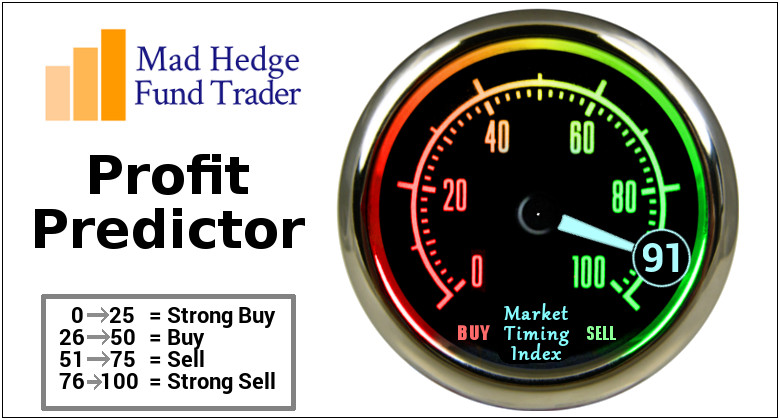
Mad Hedge Biotech & Healthcare Letter
December 26, 2019
Fiat Lux
Featured Trade:
(THE BOOM IN CANCER DRUGS),
(MRK), (CELG), (RHHBY), (BMY), (LLY), (NOVN)

Forecasting drug revenue can be a tricky business -- just ask the biotech leaders who overpromised but underdelivered.
These days, more and more variables are coming into play, with the US elections looming over us and the threat of generic meds overtaking market leaders becoming more tangible by the minute.
Another threat is the entry of biosimilars in the US, knocking down big-name drugs even in the most lucrative markets. Payers are also constantly seeking discounts, forcing tougher competition among crowded markets like diabetes and hepatitis.
However, the oncology sector remains a booming sector for the biotech industry.
Practically all major companies are either developing oncology treatments or already marketing these as blockbuster treatments, with 63 cancer drugs launched in just the past five years.
Unfortunately, not all cancer drugs are created equal. Looking at the spending on the treatments in recent years, it can clearly be seen that almost 80% of the money has been hogged by the industry leaders with the rest of the group lagging far behind.
To put things in perspective, bear in mind that the annual sales of the top 20 cancer drugs have reached over $50 billion, with $31 billion distributed among industry leaders Merck and Co (MRK), Celgene (CELG), and Roche Holdings (RHHBY).
These numbers hardly come as a surprise especially in light of over $133 billion recorded in spending for cancer treatments.
The top-selling oncology drug to date is multiple myeloma treatment Revlimid. Technically a Celgene product, the company’s $74 billion acquisition by Bristol-Myers Squibb (BMY) means the drug will be joining the other powerhouse offerings in the newly formed company’s lineup in the years to come.
With over a decade of dominance in the market and an impressive $9.7 billion in global sales annually, Revlimid has yet to hit its peak.
In fact, this mega-blockbuster is projected to exceed $15 billion in sales next year.
As if that wasn’t impressive enough, this oncology leader is estimated to bring more than double that amount come 2022.
Another dominant player in the oncology market is lung cancer drug Keytruda. Since its launch, this Merck immunotherapy leader has been able to usher in a boatload of cancer treatments using its core indications -- and it’s not yet done.
With an FDA approval eyed on June 29, 2020 for yet another indication for Keytruda, specifically for treating cutaneous squamous cell carcinoma (cSCC), its goal to dethrone Revlimid as the leader in this space now looks achievable.
Right now, Keytruda is used for various cancer types.
Aside from dominating the large addressable lung cancer market, it’s also used to treat head and neck cancer as well as melanoma. This makes Keytruda’s contributions indispensable to Merck’s overall top-line and continuous growth in sales in the past years.
Hence, it comes as no surprise that Merck’s recent third-quarter earnings had Keytruda is the starring role once again. Sales for this oncology drug jumped 62% year over year, reaching almost $3.1 billion.
One more dominant force in the oncology sector is Roche, with breast cancer drug Herceptin serving as the primary moneymaker of the company in the past 15 years.
With Herceptin raking in roughly $7 billion in annual sales in recent years, Roche has been proactive in securing its position in the oncology space by adding blockbusters ovarian cancer drug Avastin and leukemia medication Rituxan in the list.
For years, these three cancer drugs have formed the foundation of Roche’s continuous growth in the oncology sector. However, these treatments are now in danger of facing competition.
A particularly aggressive competitor is Pfizer (PFE), with its breast cancer drug Ibrance gaining traction as shown by its growing sales from $0.7 billion in 2015 to a promising $4.1 billion in 2018. Other competitors include Eli Lilly’s (LLY) Verzinio and Novartis’ (NOVN) Piqray.
To maintain its stronghold, Roche has been aggressive as well in developing new drugs.
Word has it that the company is expecting an addition $5 billion in sales for its new cancer treatments like breast cancer drugs Perjeta and Kadycla along with lung cancer medications Tecentriq and Alecensa.
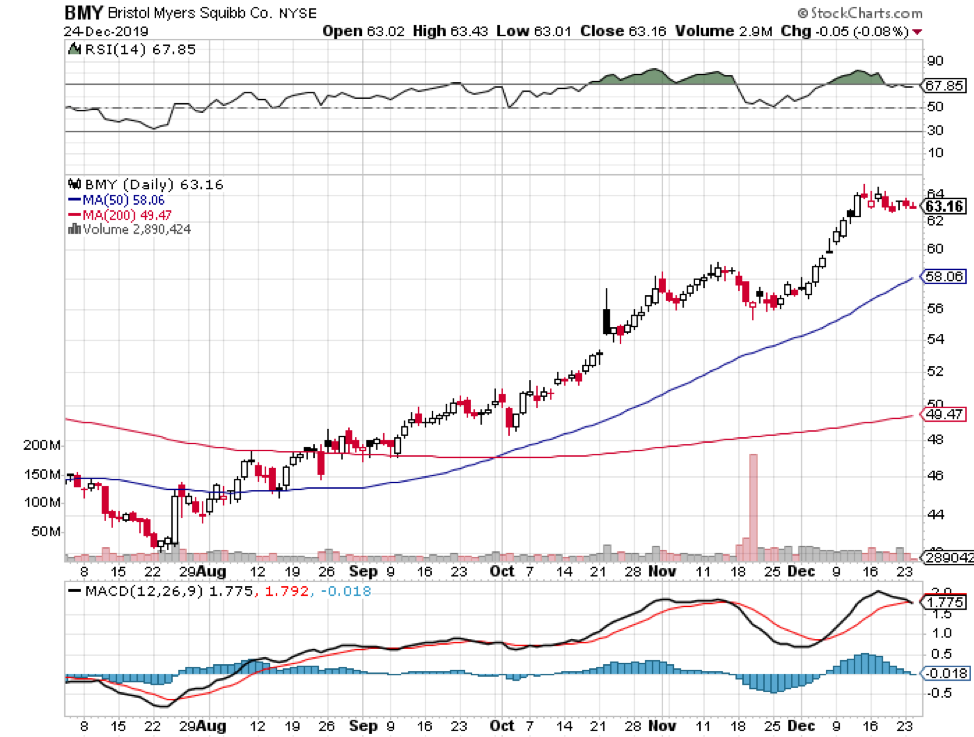
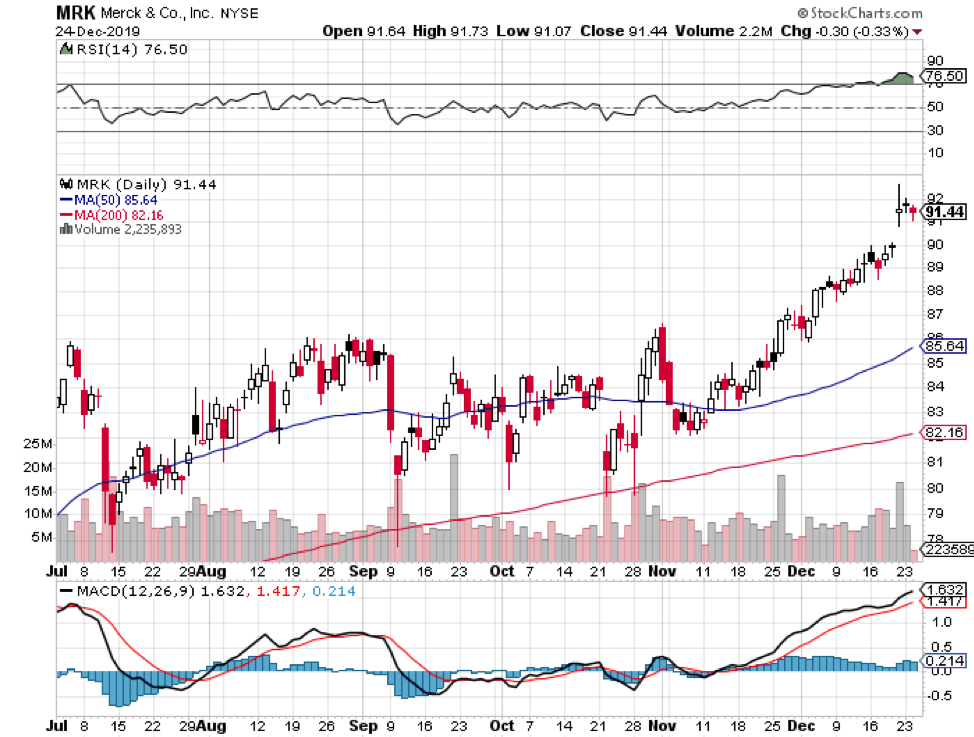
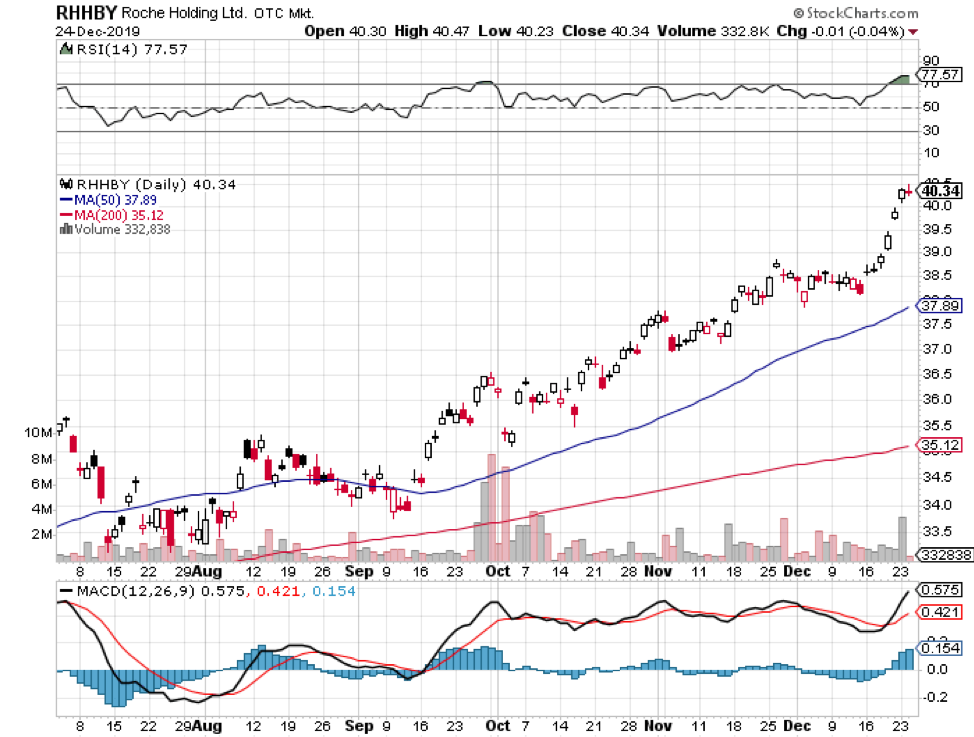
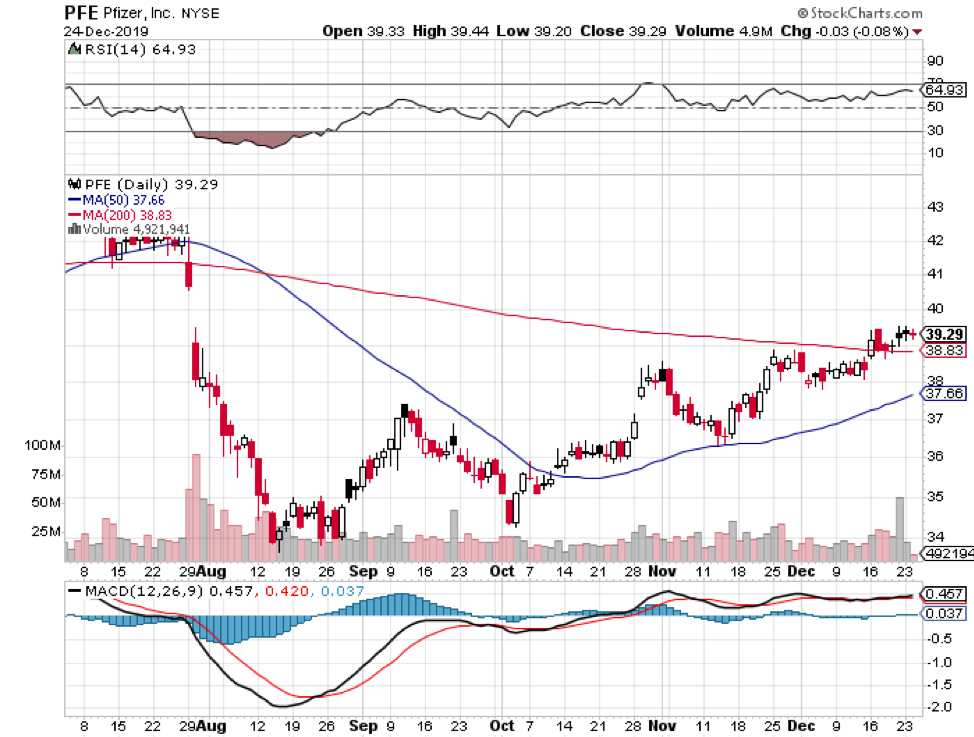
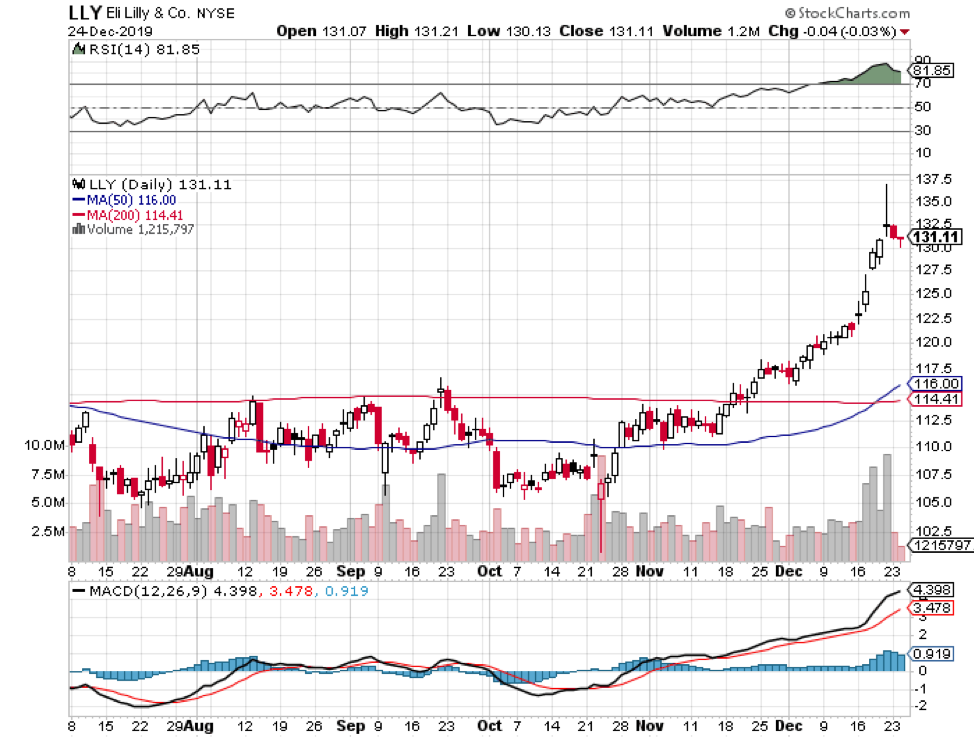
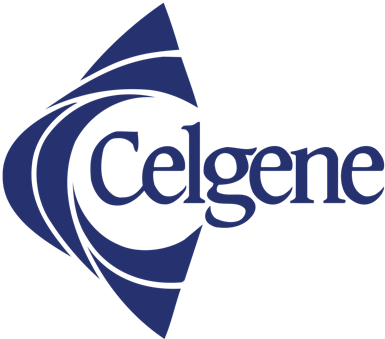
Mad Hedge Biotech & Healthcare Letter
December 17, 2019
Fiat Lux
Featured Trade:
(WHY THE M&A BOOM WILL SPILL INTO 2020),
(BMY), (CELG), (NOVN), (LOXO), (ROG), (ONCE), (MRK), (SAN), (ARQL), (THOR), (AMRN), (GSK), (AMGN), (GILD)
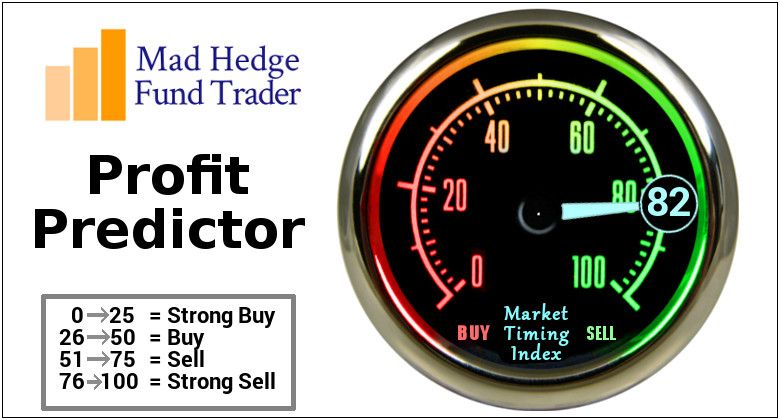
The biotech industry is breaking out, with the sector witnessing tremendous growth in the later part of 2019. With the stocks surging, it looks like the new year is setting up to a strong start that could continue well up into 2020.
Despite the anxiety over the feared government price controls in the drug sector, the early thinking in the biotech world remains optimistic. In fact, the stage seems to be set for even bigger news come 2020. This prediction comes on the heels of the over $7 billion deals closed just this summer alone.
To date, approximately $100 billion total potential value of research and development have been spent by biotech companies since June 2019, with $11 billion paid upfront in cash.
Among those deals, the biggest so far is Bristol-Myers Squibb’s (BMY) $74 billion acquisition of Celgene (CELG). Another massive agreement is Novartis AG’s (NOVN) $9.7 billion acquisition of The Medicines Company (MDCO).
Eli Lilly and Co’s (LLY) $8 billion takeover of rare genetic mutation drug Vitakvi creator, Loxo Oncology (LOXO), also signified notable movements in the industry along with Johnson and Johnson’s (JNJ) $5.8 billion buyout of robotic surgery company Auris Health. Even Roche Holding AG (ROG) is expected to complete its $4.3 billion merger with gene therapy company Spark Therapeutics (ONCE) before the year ends.
Not far behind are Merck and Co’s (MRK) $2.7 billion acquisition of ArQule (ARQL) as well as Sanofi SA’s (SAN) $2.5 billion buyout of clinical-stage DNA base pair treatment company Synthorx Inc (THOR).
The majority of the deals were in the oncology space, with three times as many oncology deals made compared to the number two sector, the neurology sector. To put things in perspective, seven of the top 10 deals made in 2019 involved oncology treatments.
What can we expect in 2020?
A number of drug candidates remain in the pipeline, but one mid-cap biotech company is anticipated to make big bucks next year. The catch? It’ll need the help of a bigger and more established company to make it happen. That is, this promising company has become the most eligible buyout candidate for 2020.
Amarin Corporation (AMRN) has taken center stage when it became the first-ever company to hit positive results for its prescription omega-3 treatment, Vascepa -- a feat that none of the other biotech giants managed to accomplish. Actually, competitor GlaxoSmithKline (GSK) created its own omega-3 treatment, Lovaza, only to have it fail to reach its goal.
Barring any major setback, Vascepa is slated as the next blockbuster treatment in the cardiovascular disease space -- possibly even displacing Pfizer’s (PFE) Lipitor as the king of this segment. In fact, several major healthcare groups like the American Heart Association, American Diabetes Association, the European Society of Cardiology have already endorsed Vascepa as an effective treatment for LDL cholesterol.
The Amarin medication is projected to peak at $4 billion in annual revenues by 2028. Considering that its manufacturer’s reported third-quarter earnings this 2019 is only at $112.4 million, the approval of Vascepa will undoubtedly be a game-changer for its investors.
However, Vascepa’s incredible potential along with the fact that Amarin has no other drug candidate in its pipeline makes the company ripe for a takeover. For one, it’s not financially capable of juggling both the marketing of Vascepa and developing or building a solid pipeline to support its growth. With the omega-3 treatment’s projected blockbuster status, a bigger and more established company could undoubtedly be more fit to help it reach its potential.
Who are the potential suitors?
Three heavyweights have been repeatedly linked to Amarin: Pfizer, Novartis, and Amgen (AMGN). Since all three have a budding cardiovascular unit, it could be anyone’s game.
However, Novartis’ recent acquisition of The Medicines Company makes it the least likely candidate in the list right now. After all, the latter already has a potential blockbuster cholesterol-lowering drug in Inclisiran.
That paves the way for a new suitor in the form of Gilead Sciences (GILD). Just a few weeks ago, Gilead added Vascepa to one of its ongoing trials involving nonalcoholic steatohepatitis. Whether or not this signifies interest in buying out Amarin is anybody’s guess.
Heading into the next year, the biotech sector is expected to welcome the new year with strong fundamentals and great opportunities for outperformance. While the election may bring changes to policies, the ongoing growth and innovation in this industry make it impossible to be excited for what’s in store for the future.
After all, more and more life-extending and even life-saving treatments are getting discovered by the day. Aside from following the developments in the industry, why not use your knowledge to fatten your pocketbook along the way?

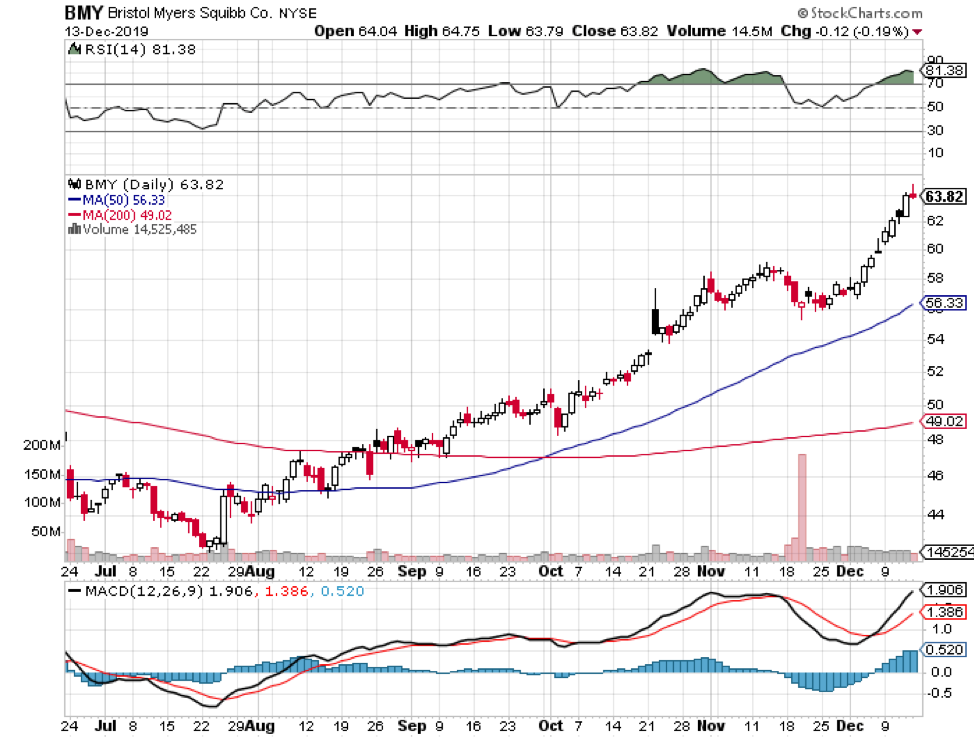
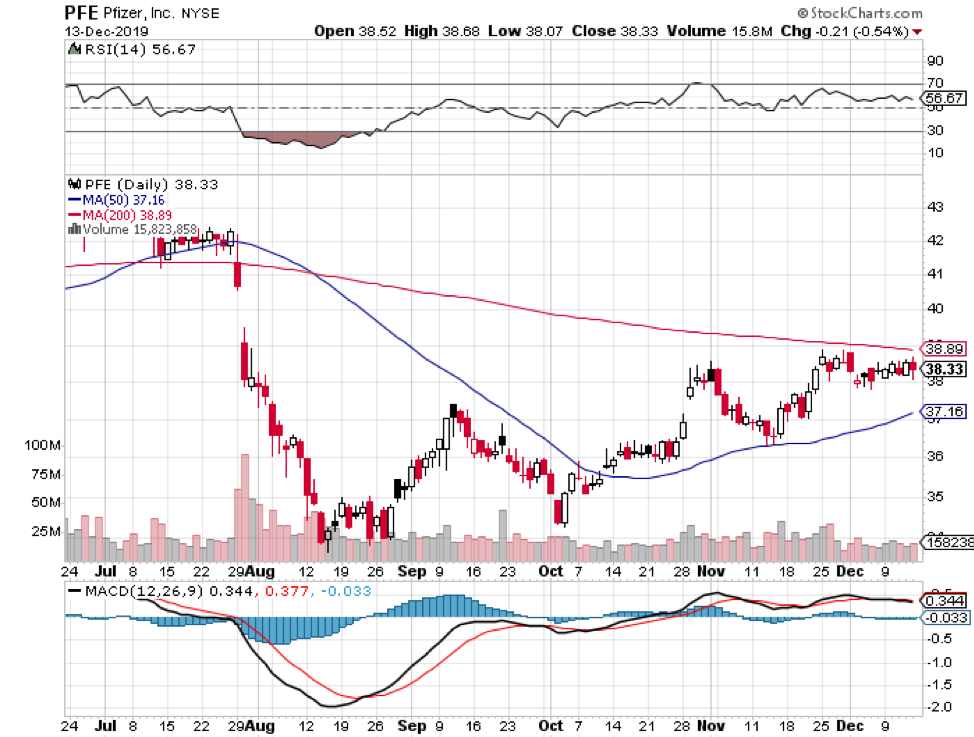

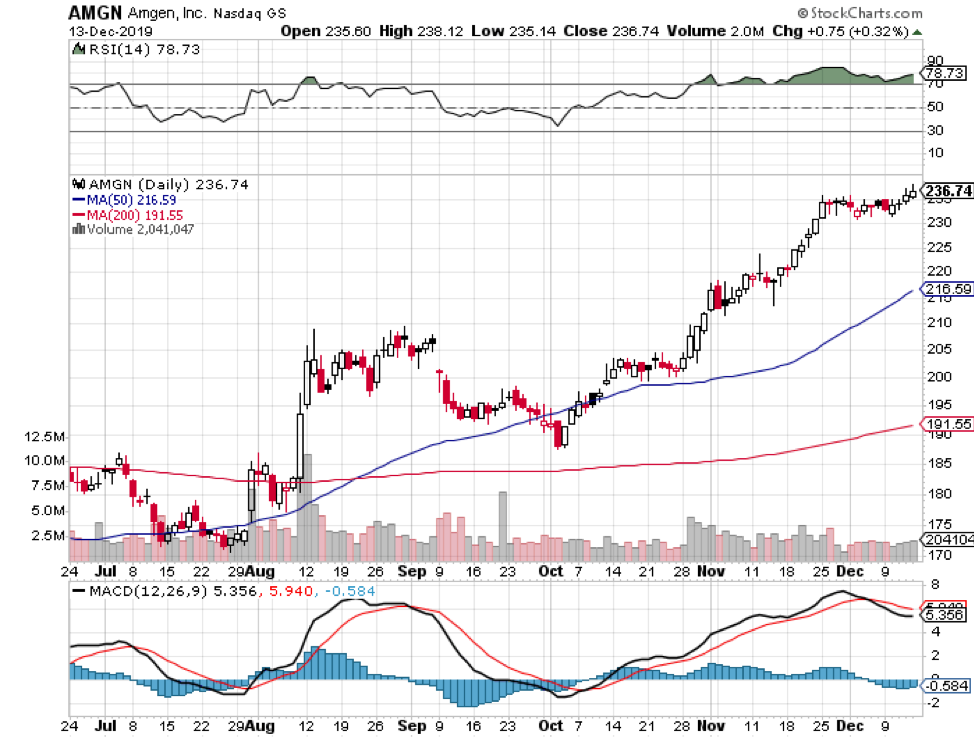
Mad Hedge Biotech & Healthcare Letter
December 12, 2019
Fiat Lux
Featured Trade:
(THE STAMPEDE INTO BIOSIMILAR DRUGS),
(BIIB), (NOVN), (REGN), (ALXN), (NITE), (PFE), (AMGN), (MRK)
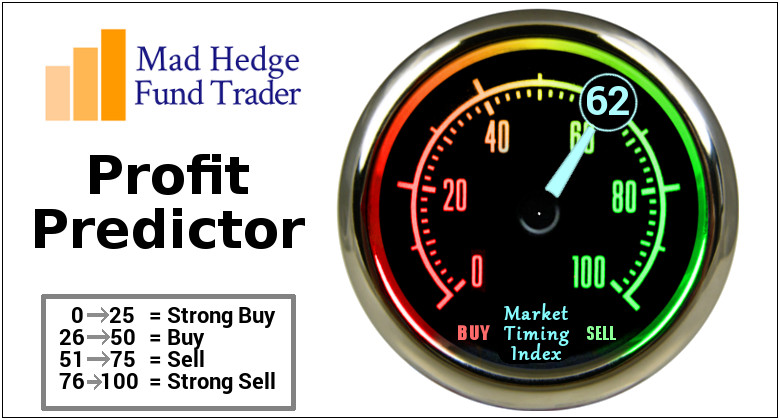
It’s been roughly a year since Biogen (BIIB) tightened its partnership with Samsung Bioepis and the Massachusetts-based biotech giant handed over an additional $100 million to funnel new programs to its own growing biosimilars pipeline.
On top of the upfront payment, the South Korean company is also eligible to gain up to $210 million depending on milestones achieved plus a $60 million fee if Biogen chooses to exercise its option in Europe. This comes in the heels of the $700 million it paid Bioepis in 2018 in an effort to boost its stake to 49.9% in their joint venture in the biosimilar space.
How has that gone?
In return, Biogen brought home two new ophthalmology biosimilars. One is a knockoff of Novartis AG’s (NOVN) prized Lucentis and the other is Regeneron Pharmaceuticals’ (REGN) top-selling Eylea. The terms of the recent deal give Biogen the exclusive commercialization rights worldwide.
Here’s a quick summary of the differences between biosimilars and generics.
Generics are identical versions of brand name products that lose patent protection. Biosimilars are considered as brand name products. However, these are highly similar to those existing branded drugs available in the market. The competitive edge of biosimilars against the “original” brand name products is the fact that they can deliver equivalent results at cheaper alternatives.
This latest update on Biogen’s partnership with Bioepis is dubbed as the “second wave” of biosimilar candidates joining the Biogen lineup. Aside from the Lucentis and Eylea biosimilars, Alexion Pharmaceuticals (ALXN) red blood cell treatment Soliris is also expected to join this batch.
Apart from that, the company can also commercialize a number of anti-tumor necrosis factor drugs in China with the list including plaque psoriasis drug Imraldi, rheumatoid arthritis treatment Benepali, and Crohn's disease medication Flicabi. Both companies have left their options open to potentially expand their current agreement in Europe for an additional five years.
Biogen’s first aggressive foray in the eye diseases sector was signified by its acquisition of clinical-stage gene therapy company Nightstar Therapeutics (NITE) earlier this year. At the time, the smaller company has already attracted attention for their research on rare retinal disorders.
Despite the promising announcements though, some investors remain wary of this growth direction Biogen has decided to pursue.
A commonly voiced concern is the issue of the production timeline, especially since neither biosimilar drug from the new deal has actually completed clinical trials to prove their efficacy compared to the reference drugs. At this point, the Lucentis biosimilar is in Phase 3 testing while the Eylea copycat is still in the preclinical phase. Patent issues are notable roadblocks as well.
Regardless of the issues, Biogen appears to be set on this track. Even before the “second wave” was implemented, the company has already presented a convincing lineup of biosimilars. A look at its third quarter earnings report showed that the biosimilars lineup managed to generate almost $184 million during that period alone, with copycat versions of Enbrel, Remicade, and Humira taking the lead in sales.
The biosimilars movement remains strong among biotech and pharmaceutical companies. Unlike in the generic drug sector, the leaders of the biosimilar movement are also the big names in the “branded” products market.
In fact, biotech heavyweights eagerly jumped at the opportunity to become frontrunners in the move to cut down on the staggering costs of branded medicine. Novartis has quickly developed its biosimilars arm, with Sandoz AG quickly taking over the European market.
Pfizer’s (PFE) partnership with South Korean biosimilar developer Celltrion Healthcare as well as its $17 billion acquisition of generic injectable pharmaceuticals producer Hospira in 2015 signify its plans to emerge as a strong contender in this sector. Even Amgen (AMGN) and Merck & Co. (MRK) have cranked up notable biosimilar development programs to join the race.
Needless to say, the biosimilar rush is all the rage right now. Big biotech companies have already learned their lesson on how the generic drugs business practically took over the pharmaceutical market, growing to almost 90% of overall prescriptions filled but only accounting for less than 30% of the total expenses. Plus, it’s also clear that big money is being made from blockbuster biologics.

Since I first recommended this stock two months ago, it has risen a ballistic 35%. In fact, so have most of our other Biotech and Healthcare recommendations.
Vertex Pharmaceuticals Inc. (VRTX) is the unequivocal king of the genetically rare lung condition cystic fibrosis (CF). To further prove its stronghold of the market, the company recently received FDA approval for its fourth CF treatment called Trikafta — five full months ahead of schedule and merely three months following the company’s application.
In a few weeks, the drug will be available in pharmacies carrying a price tag of $311,000. This puts Trikafta somewhere in the range of another prized Vertex CF treatment, Kalydeco. Sales of this newest drug is estimated to reach $4.6 billion by 2023 and more than $6.6 billion by 2025, with the drug projected to hit its peak at $10 billion by the second half of 2020.
Hence, this latest addition to Vertex’s pipeline practically guarantees the company’s supremacy over the lucrative multi-billion-dollar sector for the next decade or so. More importantly, sales from this CF drug could — at the very least — double the annual revenue of Vertex.
The projected earnings of Trikafta places it in the blockbuster tier as early as 2020, with the drug anticipated to be marketed as a treatment with a “whole new level” of efficacy compared to the earlier CF medications released by Vertex. With this new addition, the company can now reach 90% of CF patients in the United States — a huge leap from 50% it’s currently allowed to treat.
However, the launch of Trikafta is a bittersweet deal with Vertex as sales of older CF treatments are anticipated to weaken. In particular, the company expects Symdeko and Orkambi to eventually fade away from the market as more and more patients opt for the newer and more potent Trikafta.
Despite the impending success of Trikafta, it appears that Vertex has no intention of letting up. Since its CF products have translated into healthy profits in the past four quarters and a whopping $950 million in the third quarter alone, it’s no wonder the company continues to work on new offerings for this market.
Even with the weakening sales of Symdeko, the performance of CF drugs in the most recent earnings report showed a 21% jump over the same period in 2018. To date, the company has three additional treatments submitted for Phase II trials.
Beyond the CF realm, Vertex has also been looking to expand in other sectors. One of its exciting partnerships is with gene-editing company CRISPR Therapeutics (CRSP), another one of our core recommendations. (CRSP) has only doubled since September.
The two companies have been working closely to come up with game-changing treatments that could pioneer therapies for rare conditions like sickle cell disease, Duchenne muscular dystrophy, and beta thalassemia. All three of these orphan designation drugs have the potential to turn into blockbuster treatments.
For 2019, Vertex projects a product revenue somewhere between $3.70 billion to $3.75 billion. Meanwhile, its full-year earnings per share is estimated to be $4.77, which is a 17% increase from last year’s report.
A clear downside of Vertex is the fact that it’s one of the most highly valued stocks in the biotech industry at 31.1 times forward earnings. Nonetheless, a long-term study of the company’s performance would show that the shares are actually grossly undervalued even at their present-day levels.
After all, this biotech stock has the potential to triple or even quadruple its yearly revenue over the next five years or so especially if its partnership with CRISPR Therapeutics comes into fruition.
Overall, the growth and profitability profile of Vertex makes it an attractive stock to own. Add to that its promising pipeline and you have one of the most attractive names in the biotech sector. Hence, now is the ideal time for investors to buy Vertex shares as you can confidently bet on its dominance on the CF market as well as its exciting gene-editing ventures and potential revenue stream.
Keep buying both (VRTX) AND (CRSP) on the next substantial dip.

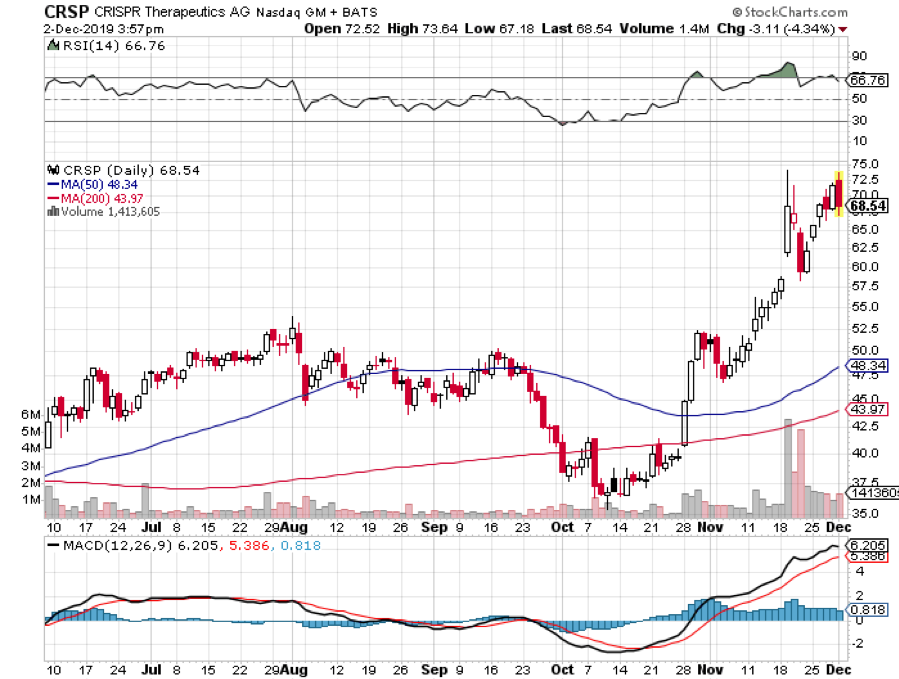
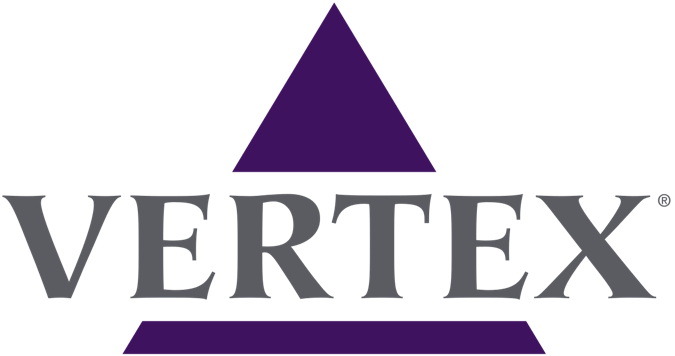
Mad Hedge Biotech & Health Care Letter
November 28, 2019
Fiat Lux
Featured Trade:
(THE BATTLE FOR YOUR HEART IS ON),
(NOVN), (MDCO), (SNY), (AMGN), (TAK)

The rumors are confirmed. Novartis AG (NOVN) has no plans of sitting out the lucrative heart treatment race. The Swiss biopharma giant made its presence known via a $9.7 billion takeover of The Medicine Company (MDCO), putting Sanofi SA (SNY), Amgen (AMGN), and Regeneron Pharmaceuticals (REGN) on high alert for some major league rivalry.
This takeover signifies the latest attempt by Novartis to redirect the future of the company, which currently has a market value of $203 billion through a number of takeovers, mergers, and disposals.
Novartis will be paying $85 in cash for every share, marking a 24% premium over The Medicine Co.’s recent closing price. In return, Novartis will gain control of the smaller biotech’s experimental cholesterol-lowering injection Inclisiran. This breakthrough treatment is currently being prepared for US approval by the end of 2019. Meanwhile, the company will mark the first quarter of 2020 with an EU filing for the treatment.
The pricey bid puts Novartis at the forefront of a market where at least one drug, high cholesterol treatment Repatha, is projected to give Amgen another blockbuster by 2021. Another similar challenger is Sanofi and Regeneron’s joint cholesterol-lowering drug Praluent. So far, these companies have been pounding away to carve out markets with steep prices.
Unfortunately, payer resistance fueled by the estimated patient population affected has been dragging their sales revenue. To add to that, prices for both medications have been limited to somewhere around $6,000 annually.
This is where Novartis’ partnership with The Medicines Company comes in handy.
To be effective, Inclisiran is only needed to be injected twice yearly to patients. This is a far cry from the 26-injection procedure required by both Amgen’s Repatha and Sanofi and Regeneron’s Praluent. The key to Inclisiran’s potency is a technology involving gene silencing or RNA interference, which basically limits “bad cholesterol” production.
Needless to say, Novartis offers an attractive option to over 58 million patients in the United States alone who cannot keep their “bad cholesterol” at bay given the current standard of care. If it gains approval, the company is looking at annual peak sales of roughly $4 billion, with Inclisiran expected to start contributing to their revenue by 2021.
Apart from that, Inclisiran is anticipated to complement Novartis’ existing combination heart failure drug Entresto, which topped the $1 billion yearly revenue threshold in 2018.
Entresto isn’t the only foray of Novartis in the cardiovascular market. Prior to this blockbuster drug, the company led the sector with high blood pressure medication Diovan, which used to rake in $6 billion annually until 2012 when it lost its patent protection.
Now, Novartis appears to be ensuring that history does not repeat itself. That is, the company has been actively seeking acquisitions in an effort to bolster its drug pipeline and portfolio with promising products and groundbreaking technologies.
While this latest deal with The Medicines Company sounds promising, Novartis remains on guard as it looks for alternatives, especially with the upcoming patent expirations of some of its main moneymakers like eye medication Lucentis, genetic blood disorder drug Exjade, and multiple sclerosis treatment Gilenya.
This deal with The Medicines Co fits hand-in-glove with the type of diversification and development projects that Novartis has been pursuing as of late. These deals include the $8.7 billion AveXis (AVXS) agreement, which allowed Novartis access to a landmark gene therapy for spinal muscular atrophy.
Prior to that, the giant biopharma acquired nuclear medicines business Advanced Accelerator Applications (AAAP) for $3.9 billion in 2017. A $2.1 billion deal with target cancer therapy maker Endocyte (ECYT) followed in 2018. Earlier this year, Novartis completed its $5.3 billion acquisition of dry eye treatment Xiidra from Takeda Pharmaceutical (TAK). So far, the Swiss giant has already spent $27.5 billion in its deal spree -- and the company isn’t going to stop anytime soon.
I know I’ve said this already, but keep buying (NOVN) on dips.
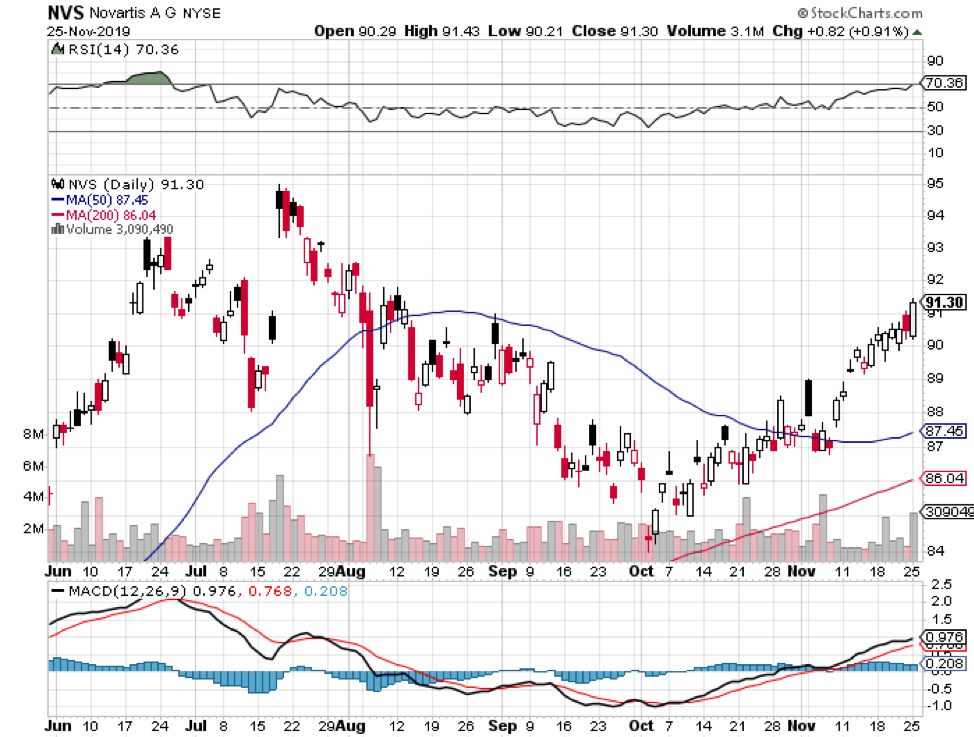
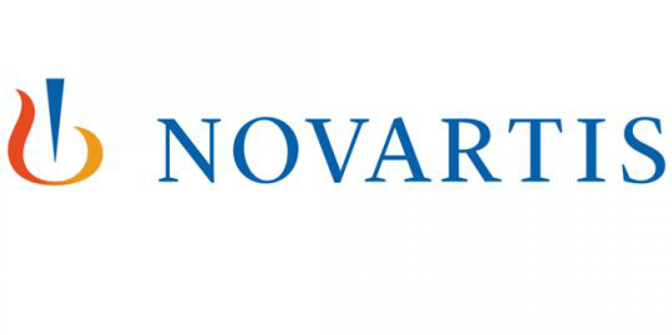
Mad Hedge Biotech & Healthcare Letter
November 19, 2019
Fiat Lux
Featured Trade:
(TAKE A WALK ON THE WILD SIDE WITH GENE EDITING),
(EDIT), (NTLA), (CRSP), (VRTX), (REGN), (NOVN)

Legal Disclaimer
There is a very high degree of risk involved in trading. Past results are not indicative of future returns. MadHedgeFundTrader.com and all individuals affiliated with this site assume no responsibilities for your trading and investment results. The indicators, strategies, columns, articles and all other features are for educational purposes only and should not be construed as investment advice. Information for futures trading observations are obtained from sources believed to be reliable, but we do not warrant its completeness or accuracy, or warrant any results from the use of the information. Your use of the trading observations is entirely at your own risk and it is your sole responsibility to evaluate the accuracy, completeness and usefulness of the information. You must assess the risk of any trade with your broker and make your own independent decisions regarding any securities mentioned herein. Affiliates of MadHedgeFundTrader.com may have a position or effect transactions in the securities described herein (or options thereon) and/or otherwise employ trading strategies that may be consistent or inconsistent with the provided strategies.
This site uses cookies. By continuing to browse the site, you are agreeing to our use of cookies.
OKLearn moreWe may request cookies to be set on your device. We use cookies to let us know when you visit our websites, how you interact with us, to enrich your user experience, and to customize your relationship with our website.
Click on the different category headings to find out more. You can also change some of your preferences. Note that blocking some types of cookies may impact your experience on our websites and the services we are able to offer.
These cookies are strictly necessary to provide you with services available through our website and to use some of its features.
Because these cookies are strictly necessary to deliver the website, refuseing them will have impact how our site functions. You always can block or delete cookies by changing your browser settings and force blocking all cookies on this website. But this will always prompt you to accept/refuse cookies when revisiting our site.
We fully respect if you want to refuse cookies but to avoid asking you again and again kindly allow us to store a cookie for that. You are free to opt out any time or opt in for other cookies to get a better experience. If you refuse cookies we will remove all set cookies in our domain.
We provide you with a list of stored cookies on your computer in our domain so you can check what we stored. Due to security reasons we are not able to show or modify cookies from other domains. You can check these in your browser security settings.
These cookies collect information that is used either in aggregate form to help us understand how our website is being used or how effective our marketing campaigns are, or to help us customize our website and application for you in order to enhance your experience.
If you do not want that we track your visist to our site you can disable tracking in your browser here:
We also use different external services like Google Webfonts, Google Maps, and external Video providers. Since these providers may collect personal data like your IP address we allow you to block them here. Please be aware that this might heavily reduce the functionality and appearance of our site. Changes will take effect once you reload the page.
Google Webfont Settings:
Google Map Settings:
Vimeo and Youtube video embeds:
